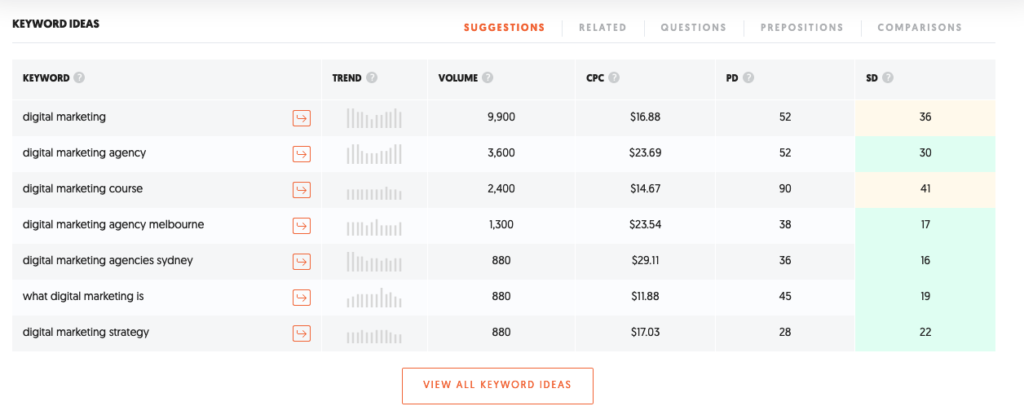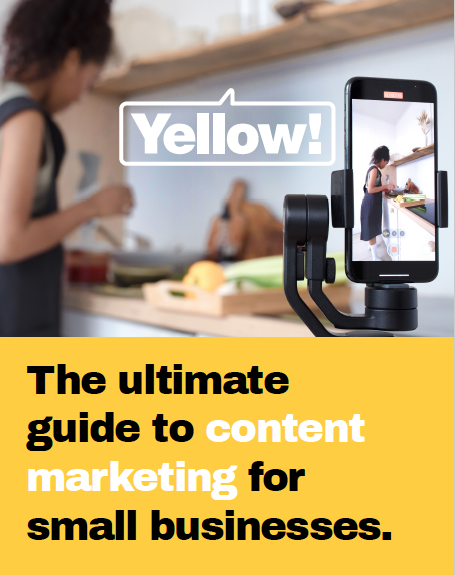In a recent Yellow Pages newsletter poll, 71% of respondents said they actively feature keywords on their website.
This is encouraging, as it shows there’s a good understanding that, if you want to drive organic traffic to your website, keywords are essential.
But simply knowing what keywords are and why they’re important isn’t enough. To really achieve success with search engine optimisation (SEO), you need to know which keywords to choose and the best practices for integrating them into your content—whether on landing pages, blogs or on third-party websites.
A disclaimer about keywords.
Before we get into the nitty-gritty of keywords there’s something you should keep in mind: keywords are just one part of a healthy SEO strategy. Simply putting keywords on your website isn’t going to move the needle in terms of your search visibility.
In addition to keywords there are other factors to consider: technical SEO, site speed, content quality, content diversity and backlinks. Without all of these elements working together at the same time, you’ll be facing some serious obstacles on your path to the first page of Google.
How to find the right keywords.
A robust keyword strategy starts with a deep look at the data available. Fortunately, there are a number of user-friendly tools that business owners can use to find the right keywords.
These tools are helpful, but they can leave you with a mountain of data that’s hard to sift through. To make it easier to filter out the keywords you should be using, let’s examine some of the most important things to look for when selecting keywords.
Here’s a screenshot from Neil Patel’s free keyword tool Ubersuggest. We’ll use this to illustrate the different keyword elements below, but you will see similar figures if you’re using a different tool.

Search volume.
When you pull keyword data, you’ll see a number indicating search volume. This figure represents the average number of searches per month for any given keyword. In the example above, we can see that ‘digital marketing’ gets about 9,900 searches per month in Australia, while ‘digital marketing agency’ gets 3,600. The higher the number, the more likely you are to see traffic to your site if you make it to the first page for that keyword.
Remember that keyword volume is not an exact science—Google is quite cagey about this information, so most tools out there are only able to give an approximation.
CPC and PD.
These two data sets are more relevant if you are using paid search as a marketing tool. CPC stands for ‘cost-per-click’ and shows you how much it would cost per click to bid for that keyword using Google Adwords. PD, or ‘paid difficulty’, indicates how competitive it is to bid for that keyword through Adwords.
Note that these numbers have some meaning for organic search as well. A higher CPC and PD means a keyword is, in some ways, more valuable. If you’re able to organically rank for high-CPC keywords, you’d be saving the money that you’d need to spend on paid ads.
SD (often called KD).
SD stands for SEO difficulty. You’ll also see this figure written as ‘keyword density’ or KD. This is perhaps the most important number for small businesses because it indicates how hard it will be for your business to rank for a keyword organically. The green color and lower number indicate an easier keyword—one that is likely more attainable than those that are highlighted yellow or red and have a higher number.
What makes a perfect keyword?
If you want to find the perfect keyword for your business to target, you are looking for words and phrases that have high search volume and low SEO or keyword difficulty.
Small businesses that are still building their SEO strategy should aim for a KD or SD score under 20. In terms of volume, it’s a bit harder to say what makes a keyword worth pursuing. This is because of something called ‘search intent’.

Understanding search intent.
Not all keywords are created equal and, to understand the true value of a keyword, you need to put on your psychology hat for a moment.
The words people type into the Google search bar can tell us a lot about what they are looking for. Let’s take three keywords from the example above to illustrate this point:
Digital Marketing | 9,900 searches per month
Digital Marketing Agency | 3,600 searches per month
Digital Marketing Agency Melbourne | 1,300 searches per month
If you were solely focused on the numbers, you might think ‘digital marketing’ is the most valuable keyword on this list. It’s got the most search volume by far, after all.
But consider what someone might be looking for if they search ‘digital marketing’ on Google. They might be looking for a definition of digital marketing, or a course about digital marketing, or a Facebook group about digital marketing. We just don’t know, which is why this keyword would be considered as demonstrating ‘low intent’.
‘Digital marketing agency’ has fewer searches but shows us more about what the user is looking for. They’re looking for an agency, but we don’t know if they are looking for a job at an agency, to hire an agency, or the name of an agency they’ve heard about from a contact. This keyword has some intent, but it’s still vague.
RELATED: Jargon-buster: Long tail keywords.
‘Digital marketing agency melbourne’ has less search volume but the highest intent. Here, we know the searcher is specifically looking for an agency in a targeted area. And though the search volume is lower, the odds that the people who are searching for that keyword are looking to hire a digital marketing agency are much higher. This makes those 1,300 searches worth a lot more than those 9,900—higher keyword intent means a higher likelihood of converting a customer.
So when you’re looking for keywords for your business, you need to balance all three of these elements. Look for keywords that show high intent, aren’t too difficult to rank for, and have a large enough search volume that it’s worth investing your time.
How keyword seasonality works.
Although we can get keyword volume through our SEO tools, it’s important to remember that these figures are just averages. In reality, keywords ebb and flow depending on what’s going on in the world in real-time.
For example, the keyword ‘Christmas gifts for men’ might have an average of 1,300 searches per month. But it may be that in November and December there are 50,000 searches, while in June there are only 200.
RELATED: SEO keywords to boost your website over the holidays.
Seasonal keywords can still be valuable. When putting together your SEO strategy, consider when you want to focus on certain keywords. Bear in mind that typically it takes 3 – 6 months for a piece of content to rank, so if you’re aiming for keywords that are popular during a certain time of year, plan accordingly.

Best practices for putting keywords into your content.
So, you’ve narrowed down your list of potential keywords and know which ones you want to target. Now comes the time to integrate those keywords into your content. So how do you do that? Here are our top tips:
Choosing a focus keyword and secondary keywords.
As a rule of thumb, it’s best to have a single keyword that you are focused on for any given page on your website. This should be the keyword you think is the most valuable using the strategy we’ve described above.
Your focus keyword should appear in the headline or title of the page, as well as the first few paragraphs. This should be easy to do because the page you are writing should be about that specific keyword. As the subject of the page, it will fit naturally into prominent spots throughout the content on its own.
You can also choose secondary keywords for a single page or content piece. However, these keywords should all be related to the same general topic. For example, if your primary keyword is ‘best florists in St Kilda’, you could have secondary keywords like ‘St Kilda florists’ and ‘where to buy bouquets in St Kilda’. A keyword like ‘Melbourne florists’ wouldn’t be at home on this page, because it’s much broader (and likely deserves a landing page of its own).
How to avoid keyword stuffing.
One of the most common mistakes when writing SEO-focused content is something known as ‘keyword stuffing’ — which means jamming too many keywords into a single piece of content.
If there’s one thing Google wants more than anything else, it’s well-written content. If you’ve spent too much time trying to force keywords in where they don’t fit, or putting too many keywords into a single piece of content, you could get penalised by Google (making it virtually impossible to rank).
Instead, aim to put one keyword every three hundred words or so. If a keyword won’t fit because of the way it’s phrased, it’s best to just leave it out rather than shoehorning it in awkwardly. Google is getting smarter every day and learning how to understand a web page in context, so leaving out one or two of your keywords won’t harm your overall strategy.
Integrating keywords into sub-headers.
Sub-headers are the mini-headlines you see in articles like the one you’re reading right now. (In fact, ‘Integrating keywords into sub-headers’ is a sub-header itself!) These are vital for any written content, whether you’re creating a landing page or a long-form blog. Sub-headers help break up the text and make it easier for readers to navigate the page to find the information they are looking for.
But sub-headers also have a role to play with keywords. When you formally put a sub-header into your text, you can mark it with a code like ‘H1’, ‘H2’, ‘H3’ etc. These tags are usually implemented on the back-end of your content management system (CMS) when you are uploading content. At the front end, H-tags make your sub-headers different font sizes: H1 will be the largest, H2 the next largest and so on. In this article you’re reading now, you can see we use a number of H-tags—the one immediately above this – ‘Integrating keywords into sub-headers’ – is an H3, while the tag at the top of this section – ‘Best practices for putting keywords into your content’ – is an H2.
These tags and sub-headers make it easier for readers to navigate your content—a ‘wall of text’ with no sub-headings usually drives readers away. But they also serve an important purpose when it comes to keywords and SEO.
By tagging your sub-headers, you’re saying to Google ‘Hey, this line is important!’. If you have your focus or secondary keywords in some of your headings, Google will pick up on that and consider that when determining where to rank your page.
This doesn’t mean you need to shoehorn in keywords for every single sub-header. Instead, put them in only if they fit naturally and read well. Since your primary and secondary keywords should all be around the same topic, it’s likely you’ll find two or three opportunities per article for keyword-sub-headers.

Integrating keywords into anchor text.
Anchor text refers to the string of words you use when linking to another page—you’ll recognise them because they are usually written in blue text and underlined, and clickable.
Links play a big part in SEO in two different ways.
First, let’s talk about internal linking. This happens when you link one page of your website to another page on the same site. This makes it easier for both users and Google to find relevant pages on your website.
As an example, let’s say you own a dog grooming service and one of your main keyword targets is ‘expert dog groomer’. You already have a page dedicated to this phrase but when writing a blog about what to look for in a dog groomer, you write this sentence:
‘If you’re looking for an expert dog groomer, don’t be afraid to ask them for their credentials and experience.’
In this example, the words ‘expert dog groomer’ would be considered anchor text and you would link it to your primary ‘expert dog groomer’ landing page.
Similar rules apply to external linking, which refers to links from other websites to your website. External links, also known as backlinks, are a vital part of any SEO strategy. There are a number of ways to get backlinks to your website, such as guest blogging, collaborations, and directory listings.
RELATED: Why is backlinking so important for SEO?
In some cases, you may have some control over the anchor text in an external link. For example, if you’re writing a guest blog for a related website you can strategically link back to your own website using your primary keywords as anchor text.
If you don’t have the opportunity to choose the anchor text in a third-party piece of content, don’t sweat it. Backlinks are almost always a good thing, assuming they come from a legitimate website.
How digital marketing from Yellow Pages helps your business grow online.
The team at Yellow Pages provides expert digital marketing advice and products that boost your business’ online presence. From an online listing to digital display or social media ads, we’ll tailor a digital marketing strategy designed for your business. Find out more.
